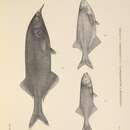Diagnostic Description
provided by Fishbase
Diagnosis: Marcusenius macrolepidotus is best distinguished from M. altisambesi by the number of circumpeduncular scales, which is 12-18 vs. 12-14, and an electric organ discharge lacking an initial head-negativity; from M. devosi by the number of scales in linear series along the lateral line row, which is 52-62 vs. 56-66, shorter caudal peduncle length, and weaker Namp of its electric organ discharge; from M. pongolensis by the number of scales in linear series along the lateral line row, which is 52-62 vs. 70-76, the umber of circumpeduncular scales, which is 12-18 vs. 16-20, a greater body depth, and longer Ndur of its electric organ discharge in females and juveniles; and from M. angolensis by its lower number of anal fin rays, being less than 31 vs. 33, and dorsal fin rays, being less than 24 vs. 26, and a higher number of circumpeduncular scales (Ref. 75962).Description: Head with terminal mouth well in front of eye, mental lobe on lower jaw protruding beyond upper jaw; head and body dorsolaterally compressed (Ref. 4967, 13337, 75962). Dorsal fin situated about two thirds of standard length from snout, obliquely orientated, anteriorly higher and posteriorly lower, proximal tip rounded, distal tip sharply pointed, distal margin sometimes only slightly crescentic with anterior two or three rays longer than posterior rays, number of rays 20-24; anal fin opposite dorsal fin with distinctly more anterior origin, obliquely orientated, anteriorly lower and posteriorly higher, anterior rays longer than posterior ones, especially in males where they also appear stronger and often darkened, distal margin crescentic, number of rays 26-31 (Ref. 75962). Scales cycloid with reticulate striae, scales extending anteriorly to operculum and pectoral fins; scales on caudal peduncle circumference, 12-18 (Ref. 75962). Caudal peduncle relatively deep, subcylindrical entire length, 17-21% of standard length (Ref. 75962). Electric organ discharge biphasic lacking a weak pre-potential, Pdur around 183 µs, Ndur around 174 µs, Pamp and Namp of similar strength (Ref. 75962).Colouration: Colour in life: back and sides grey-silver, dark on the back and lighter on the sides, to very fair on the underside, gold-olive or purple shimmer depending on angle of light incidence, dark-grey blotches on sides and on unpaired fins, especially on the tail, but absent on head and belly, area next to first ray of anal fin darker, less distinct in females (Ref. 75962). Colour in preservation: blackish-brown on back, fading into ochre on lower body parts, light ochre on underside, blotches seen in life less distinct in preservation (Ref. 75962).
Migration
provided by Fishbase
Potamodromous. Migrating within streams, migratory in rivers, e.g. Saliminus, Moxostoma, Labeo. Migrations should be cyclical and predictable and cover more than 100 km.
Morphology
provided by Fishbase
Dorsal spines (total): 0; Dorsal soft rays (total): 20 - 24; Analspines: 0; Analsoft rays: 26 - 31
Trophic Strategy
provided by Fishbase
Prefers well-vegetated, muddy bottomed marginal habitats of rivers and floodplains. A shoaling species which moves inshore after dark. Frequency of occurence in Caprivi: occasionally in sandy streams, occasionally on rocky streams, common in standing deep water, common in shallow swamps, and common in shallow flood plains (Ref. 037065). Migrates within rivers. Recorded to move up tributaries in shoals during flood season (Ref. 13337). Feeds on invertebrates, especially midge and mayfly larvae and pupae taken from the bottom and off plant stems.
- Recorder
- Drina Sta. Iglesia
Biology
provided by Fishbase
Caught with dipnets in the Kafue floodplain, Zambia. Prefers well-vegetated, muddy bottomed marginal habitats of rivers and floodplains. A shoaling species which moves inshore after dark. Migrates within rivers. Recorded to move up tributaries in shoals during flood season (Ref. 13337). Feeds on invertebrates, especially midge and mayfly larvae and pupae taken from the bottom and off plant stems. Breeds during the rainy season in shallow vegetated localities; females carry up to 6,000 eggs (Ref. 7248). Possesses electroreceptors over the entire head and on the ventral and dorsal regions of the body, but absent from the side and the caudal peduncle where the electric organ is located (Ref. 10011).
Importance
provided by Fishbase
gamefish: yes; aquarium: commercial

